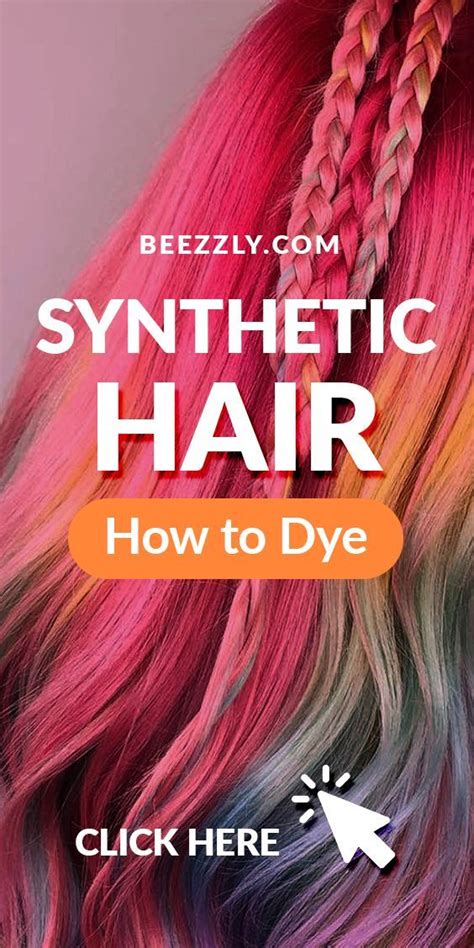Introduction
Synthetic hair dye is a chemical substance used to alter the color of human hair. It is made from a variety of ingredients, including pigments, developers, and conditioners. Synthetic hair dye is available in a wide range of colors, from natural shades to vibrant hues. It can be used to cover gray hair, change the color of hair, or create highlights or lowlights.

Types of Synthetic Hair Dye
There are two main types of synthetic hair dye: permanent and semi-permanent.
Permanent Hair Dye
Permanent hair dye contains ammonia, which opens up the hair shaft and allows the dye to penetrate the cortex. This type of dye is long-lasting and will not wash out. It is typically used to cover gray hair or to change the color of hair dramatically.
Semi-Permanent Hair Dye
Semi-permanent hair dye does not contain ammonia. It coats the hair shaft but does not penetrate the cortex. This type of dye is less permanent than permanent hair dye and will gradually wash out over time. It is typically used to add highlights or lowlights to hair or to refresh the color of hair that has been dyed previously.
How to Choose the Right Synthetic Hair Dye
When choosing a synthetic hair dye, it is important to consider the following factors:
- The desired color: What color do you want to achieve?
- The condition of your hair: Is your hair healthy or damaged?
- Your hair type: Is your hair fine, medium, or thick?
- Your skin tone: What is your skin tone?
- Your budget: How much money are you willing to spend?
How to Apply Synthetic Hair Dye
Applying synthetic hair dye is a relatively simple process. However, it is important to follow the instructions carefully to avoid damaging your hair.
Step 1: Prepare your hair
Before applying synthetic hair dye, you should wash your hair with a clarifying shampoo to remove any dirt or oil. Do not condition your hair.
Step 2: Divide your hair
Divide your hair into four sections: two in the front and two in the back. Clip up the top two sections.
Step 3: Apply the dye
Apply the dye to the roots of your hair first. Use a brush to apply the dye evenly. Then, work the dye through the rest of your hair. Be sure to saturate your hair completely.
Step 4: Process the dye
The processing time will vary depending on the type of dye you are using. Follow the instructions on the package.
Step 5: Rinse and style
Once the processing time is complete, rinse your hair thoroughly with warm water. Then, condition your hair and style as usual.
Tips for Using Synthetic Hair Dye
- Always do a strand test before applying synthetic hair dye to your entire head. This will help you to determine how the dye will react with your hair.
- Follow the instructions on the package carefully.
- Do not leave the dye on your hair for longer than the recommended time.
- Rinse your hair thoroughly after applying the dye.
- Condition your hair after applying the dye to help restore moisture.
- Use a heat protectant spray before using heat styling tools.
- Avoid swimming in chlorinated water after applying the dye.
Benefits of Synthetic Hair Dye
There are many benefits to using synthetic hair dye, including:
- It can cover gray hair. Synthetic hair dye is an effective way to cover gray hair.
- It can change the color of hair. Synthetic hair dye can be used to change the color of hair dramatically or to add highlights or lowlights.
- It is relatively inexpensive. Synthetic hair dye is less expensive than professional hair coloring services.
- It is easy to apply. Synthetic hair dye is easy to apply at home.
Risks of Synthetic Hair Dye
There are some risks associated with using synthetic hair dye, including:
- It can damage hair. Synthetic hair dye can damage hair if it is not used properly.
- It can cause allergic reactions. Some people may experience allergic reactions to synthetic hair dye.
- It can be toxic. Synthetic hair dye contains chemicals that can be toxic if they are ingested or inhaled.
Alternatives to Synthetic Hair Dye
There are a number of alternatives to synthetic hair dye, including:
- Natural hair dyes
- Henna
- Semi-permanent hair color
- Hair extensions
Conclusion
Synthetic hair dye is a versatile and affordable way to change the color of your hair. However, it is important to use it safely and correctly to avoid damaging your hair.
Frequently Asked Questions
Q: What is the difference between permanent and semi-permanent hair dye?
A: Permanent hair dye contains ammonia, which opens up the hair shaft and allows the dye to penetrate the cortex. Semi-permanent hair dye does not contain ammonia and coats the hair shaft but does not penetrate the cortex.
Q: How long does synthetic hair dye last?
A: Permanent hair dye is long-lasting and will not wash out. Semi-permanent hair dye will gradually wash out over time.
Q: Can I use synthetic hair dye to cover gray hair?
A: Yes, synthetic hair dye can be used to cover gray hair.
Q: What are the risks of using synthetic hair dye?
A: Synthetic hair dye can damage hair if it is not used properly. It can also cause allergic reactions and be toxic if it is ingested or inhaled.
